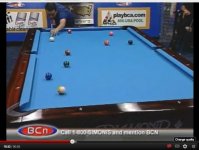I thought the "Left" side* was the literal side?:wink:
One thing that I've been trying to explain and it's very challenging
"you must form a relationship between your hand and your tip". The "hammer drill" is something that I've used with success to teach how the hand/wrist/fingers move the cue and deliver "energy" to the tip.
This is a force that transfers through the tip into the cue ball. So
the wrist/hand/fingers effect the tip whether you're aware of it or not. I recommend being aware of it and seeking to strengthen the relationship and direct effect that your hand has on the tip THROUGH the pool cue.
I know this is a round about way to answer your question, and I think you can understand it's easy for me to show and difficult for me to explain.
Connecting your hand and tip is ESSENTIAL to at least explore.
So with that said, hit some balls with your cue angled so the tip is
BELOW center and use your hand/wrist/fingers to
make the top edge of your cue go up (using your shooting hand/fingers) to produce topspin on the cue ball.
Think in terms of putting topspin on a basketball by hitting up on it BELOW it's center. You wouldn't hit the basketball HIGH on the ball to produce maximum topspin you would "brush up on the ball", LOW to HIGH.
Please don't take this literally, I'm just trying to give you a visual analogy to help "
get the idea" of using the top of the tip to generate topspin (high english). If that doesn't make sense I'll try in another way later tonight, for now I have to go play a game myself.
*
Hi CJ-
I'm struggling a bit with this 'next level' "
pinning" concept.
I understand the examples of rubbing, brushing the basketball or tennis ball with an upward contact motion of hand or racquet to create the overspin.(reminds me of the upward glancing blow to the back of head motion:wink

How are you getting that action on the cb at contact?
A pure pendulum stroke seems to create a downward path at contact with cb.
Dropping the elbow seems to help negate that trajectory, and provide a more even level path through the cueball at contact.
So-is this upward tip motion created by lowering the back hand just before contact, to cause the tip to come up, engage the 'top half' of the tip, and create a mini-upward tip flip while still moving the tip and shaft forward?
(bridge being the fulcrum of this shaft orientation teeter-totter)
Can you tell that I'm confused, and trying to visualize how to acheive this upward ball brushing motion?
thanks for any comment
take care

